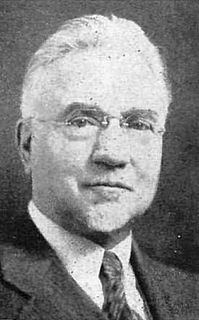Related Research Articles

Brigham Young was an American religious leader and politician. He was the second president of The Church of Jesus Christ of Latter-day Saints from 1847 until his death in 1877. He founded Salt Lake City and served as the first governor of the Utah Territory. Young also led the foundings of the precursors to the University of Utah and Brigham Young University.
In Latter-day Saint belief, the restoration refers to a return of the authentic priesthood power, spiritual gifts, ordinances, living prophets and revelation of the primitive Church of Christ after a long period of apostasy. While in some contexts the term may also refer to the early history of Mormonism, in other contexts the term is used in a way to include the time that has elapsed from the church's earliest beginnings until the present day. Especially in The Church of Jesus Christ of Latter-day Saints "the restoration" is often used also as a term to encompass the corpus of religious messages from its general leaders down to the present.
Over the past two centuries, the relationship between black people and Mormonism includes both official and unofficial discrimination. From the mid-1800s until 1978, the LDS Church prevented most men of black African descent from being ordained to the church's lay priesthood, barred black men and women from participating in the ordinances of its temples and opposed interracial marriage. Since black men of African descent could not receive the priesthood, they were excluded from holding leadership roles and performing these rituals. Temple ordinances such as the endowment and marriage sealings are necessary for the highest level of salvation. The church's first presidents, Joseph Smith and Brigham Young, reasoned that black skin was the result of the Curse of Cain or the Curse of Ham. As early as 1844, leaders suggested that black people were less valiant in the pre-existence. Many leaders, including Ezra Taft Benson, were vocally opposed to the civil rights movement.

David Oman McKay was an American religious leader and educator who served as the ninth president of The Church of Jesus Christ of Latter-day Saints from 1951 until his death in 1970. Ordained an apostle and member of the Quorum of the Twelve Apostles in 1906, McKay was a general authority for nearly 64 years, longer than anyone else in LDS Church history, except Eldred G. Smith.

Jeffrey Roy Holland is an American educator and religious leader. He served as the ninth President of Brigham Young University and is a member of the Quorum of the Twelve Apostles of The Church of Jesus Christ of Latter-day Saints. As a member of the Quorum of the Twelve, Holland is accepted by the church as a prophet, seer, and revelator. Currently, he is the fourth most senior apostle in the church.

John Andreas Widtsoe was a member of the Quorum of the Twelve Apostles of The Church of Jesus Christ of Latter-day Saints from 1921 until his death. Widtsoe was also a noted author, scientist, and academic.

The 1890 Manifesto is a statement which officially advised against any future plural marriage in The Church of Jesus Christ of Latter-day Saints. Issued by church president Wilford Woodruff in September 1890, the Manifesto was a response to mounting anti-polygamy pressure from the United States Congress, which by 1890 had disincorporated the church, escheated its assets to the U.S. federal government, and imprisoned many prominent polygamist Mormons. Upon its issuance, the LDS Church in conference accepted Woodruff's Manifesto as "authoritative and binding."
Joseph Fielding McConkie was a professor of Ancient Scripture at Brigham Young University (BYU) and an author or co-author of over 25 books.
The Church of Jesus Christ of Latter-day Saints has been subject to criticism and sometimes discrimination since its early years in New York and Pennsylvania. In the late 1820s, criticism centered around the claim by Joseph Smith to have been led to a set of golden plates from which the Book of Mormon was reputedly translated.
The 1978 Revelation on Priesthood was a revelation announced by leaders of The Church of Jesus Christ of Latter-day Saints that reversed a long-standing policy excluding men of black African descent from the priesthood.
Marcus Helvécio Martins is the former dean and department chair for religious education at Brigham Young University–Hawaii (BYU–Hawaii), and also the author of Setting the Record Straight: Blacks and the Mormon Priesthood. Martins was the first black member to serve as a missionary after the revelation extending the priesthood of The Church of Jesus Christ of Latter-day Saints to all male members regardless of race or color. Martins is the son of Helvécio Martins, the first Latter-day Saint of African descent to serve as an LDS Church general authority.

Susan Easton Black is a retired professor of Church History and Doctrine at Brigham Young University (BYU) in Provo, Utah. She is also an author of several books related to Joseph Smith and the early history of The Church of Jesus Christ of Latter-day Saints.
Arnold Kent Garr was the chair of the department of Church History and Doctrine at Brigham Young University (BYU) from 2006 to 2009. He was also the lead editor of the Encyclopedia of Latter-day Saint History.
Grant Revon Underwood is a historian of The Church of Jesus Christ of Latter-day Saints and a professor at Brigham Young University (BYU). He is also the author of The Millennial World of Early Mormonism and the editor of Voyages of Faith: Explorations in Mormon Pacific History.
Steven Craig Harper is a professor of church history and doctrine at Brigham Young University. He was a historian for the Church History Department of The Church of Jesus Christ of Latter-day Saints. From 2019, he is the Editor-in-Chief of BYU Studies Quarterly.
Jill Mulvay Derr was a senior research historian in the Church History Department of The Church of Jesus Christ of Latter-day Saints from 2005 to 2011. She previously served as Managing Director of the Joseph Fielding Smith Institute for Latter-day Saint History at Brigham Young University (2003-2005), where she was also Associate Professor of Church History (1998-2005). Her research and publications have focused on the history of Mormon and Utah women, and she is past president of the Mormon History Association (1998-1999).
Harry Donl Peterson was a religion professor at Brigham Young University (BYU) who primarily studied topics related to the Book of Mormon and Pearl of Great Price.
From 1849 to 1978, The Church of Jesus Christ of Latter-day Saints prohibited men of black African descent from being ordained to the priesthood. In 1978, the church's First Presidency declared in a statement known as "Official Declaration 2" that the restriction had been lifted. Between 1830 and 1849, a few black men had been ordained to the priesthood under Joseph Smith.

Black people have been members of Mormon congregations since its foundation, although the church placed restrictions on proselytization efforts among black people. Before 1978, black membership was small. It has since grown, and in 1997, there were approximately 500,000 black members of the church, mostly in Africa, Brazil and the Caribbean. Black membership has continued to grow substantially, especially in West Africa, where two temples have been built. By 2018, an estimated 6% of members were black. In the United States, 3% of members are black.
In The Church of Jesus Christ of Latter-day Saints, marriage between a man and a woman is considered to be "ordained of God". Marriage is thought to consist of a covenant between the man, the woman, and God. The church teaches that in addition to civil marriage, which ends at death, a man and woman can enter into a celestial marriage, performed in a temple by priesthood authority, whereby the marriage and parent–child relationships resulting from the marriage will last forever in the afterlife.
References
- 1 2 "BYU religion prof Bott retiring in June", Daily Herald (Utah) , 22 March 2012, retrieved 22 August 2013
- ↑ BYU Alumni Directory (Restricted access), BYU, retrieved 1 June 2008
- 1 2 3 "Randy L. Bott", Religious Education: Faculty Directory, BYU, retrieved 22 August 2013
- ↑ Masters, Lauren (13 February 2003), "Happily ever after: Professor love stories", The Daily Universe , retrieved 22 August 2013
- ↑ "Beehives and Buffalo Chips", Daily Herald, 13 December 2008, retrieved 22 August 2013
- ↑ Walsh, Tad (11 December 2008), "BYU professor sits atop national rankings", Deseret News , retrieved 22 August 2013
- ↑ Peterson, Janice (9 December 2008), "BYU professor rated 2008's best on Web site", Daily Herald, retrieved 22 August 2013
- ↑ "Top 10". Ratemyprofessors.com. Archived from the original on 19 December 2008. Retrieved 20 December 2008.
- 1 2 Horowitz, Jason (28 February 2012), "The Genesis of a church's stand on race", The Washington Post, retrieved 22 August 2013
- ↑ "Interview: Jeffrey Holland", The Mormons , PBS, 2007, retrieved 22 August 2013
- ↑ "Official Statement – Race and the Church: All Are Alike Unto God", Newsroom (mormonnewsroom.org), LDS Church, retrieved 22 August 2013
- ↑ Bennion, Kate (February 29, 2012), "Washington Post article on black priesthood ban spurs concern, outrage: Professor didn't follow university media policy when speaking with newspaper", The Daily Universe, retrieved 22 August 2013
- ↑ Walker, Joseph (29 February 2012), "LDS Church condemns past racism 'inside and outside the church'", Deseret News, retrieved 22 August 2013
- ↑ "Gospel Topics – Race and the Priesthood", churchofjesuschrist.org, LDS Church, retrieved 2 January 2014
- ↑ Rick B (9 November 2020). "Race, Priesthood, and Randy Bott" . Retrieved 7 November 2021– via Wheat & Tares.